| A Bit of History
(Or: Why a Fisher 30?) |
In 2001, after a 2-year restoration, we launched our
1963 Pearson Triton Glissando, a great boat that
we owned through the end of the 2011 sailing season,
when, with greatly mixed feelings, we sold her to make
way for the new boat ahead.
Click here to go to a detailed website about
Glissando.
After several years of sailing and cruising, we started
thinking ahead to the future. The Glissando
project, while a success in all ways, had highlighted a
number of areas where her small size and my relative
inexperience had inevitably compromised certain aspects
of the boat--at least as my ever-growing skill set and
knowledge led me to believe. In
addition, I had a strong desire to use the past lessons
learned to rebuild another custom boat, as well as some
thoughts about extending our cruising area and,
eventually, scope to where we might crave a bit more
interior and stowage space.
In 2004, a friend pointed me towards a 35' Allied
Seabreeze yawl that had suffered a gasoline fire and was
heavily damaged. At the time, this seemed the
perfect "next" boat: bigger in all ways, but not
overly so, and with known and appealing sailing
characteristics and overall appearance. After
inspecting the boat, I bought the burned hulk and
brought her to Maine, planning to begin reconstruction
work in the near future. |
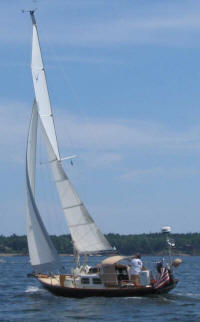 |
Click here to go to a website about the Allied Seabreeze
project.
 Shortly
thereafter, in early 2005, we made a decision to move to
a new property, a project that consumed time and
resources for several years. This put the
Seabreeze project on hold for 5 years, during which time
I was heavily involved with infrastructure, house, and
shop construction at the new property and, afterwards,
with running my
boat restoration business. Shortly
thereafter, in early 2005, we made a decision to move to
a new property, a project that consumed time and
resources for several years. This put the
Seabreeze project on hold for 5 years, during which time
I was heavily involved with infrastructure, house, and
shop construction at the new property and, afterwards,
with running my
boat restoration business.
Finally, in late 2009 it seemed the time to begin the
project had come, and with great anticipation I moved
her into my shop and attacked the interior demolition
and, I thought, the structural repairs to her
fire-damaged stern quarters. |
A lot had changed since 2004, when we first bought the
Seabreeze. I'd changed, and how we used our boat
had changed, as had how we expected to use the boat in
the future. These changes, and the passing of
time, would play a large role in a decision in 2010 to
abandon the Seabreeze project and seek a new direction.
As gung-ho as I'd been when I began the project in
October 2009, the more I got into the hull damage at the
aft end of the boat, the worse it seemed to get. I
knew the boat was badly burned and damaged; this was
clear from the onset, and the overall scope of the
project never worried me. What I'd not properly
anticipated was how badly the heat of the fire had
affected the laminate in the stern quarters: it
was far worse than expected.
But the extent of damage alone wasn't the deciding
factor in the decision. I still had confidence in
the repair technique I'd have pursued, but after a few
months' of weekends worth of foul, dirty demolition and
grinding, I found myself burned out and, with plenty of
other irons in the fire, I drifted away from the
project. During this time, I looked within and
decided that one reason I was dragging my feet was that
I had questions about whether this was the right boat to
be rebuilding at this time. Maybe I didn't want
to invest the next several years and thousands of
dollars into this boat.
So while it would have been understandable to abandon
the project simply because of the extent of the damage,
that really wasn't the problem: the problem was
that I'd changed, and my thoughts about cruising had
changed. That said, there was no question that we
were ready for a new challenge, and another boat. |

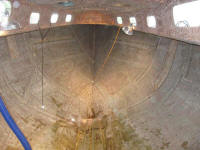
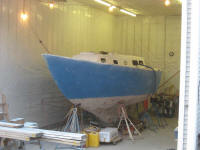 |
Plus, my thoughts about what we did while cruising had
changed, and for years I'd harbored a secret love, one which
I'd never admitted to another soul until July 2010:
I liked motorsailers. Oh, not all motorsailers,
mind you. Form and function were important, but
when done "correctly" (whatever that means; it probably
means something different to each of us), I was a big
fan.
What's my definition of a motorsailer, by the way?
It's a displacement boat that's designed to spend most
of its time with the engine running, usually assisted by
sail, and occasionally powered by sail alone.
Others have different self-definitions. This is
mine.
I spent a lot of time researching the concept, and for a
time considered building something custom from scratch.
I collected ideas, photos, and concepts, but although
this was a fun exercise, ultimately reality set in: I thought it would take
longer than I wanted to build something from scratch,
and would also cost too much for what I was considering
building--not to imply that I couldn't build
something within current budget constraints--just
not what I was envisioning. I shelved the new
construction ideas for the moment.
Since the 70s, when I was young and devoured every
sailing magazine in sight (and they were good back
then), I'd loved Fishers. I'd always loved the high, bluff bows that
looked ready to smash aside any sea and the North
Sea-type forward-raked wheelhouse. But after some
momentary excitement, once again reality hit home:
Fishers, and particularly the 37s (my ideal) were out of
the price possibility for us. Even the
lowest-price Fisher 37 I could find, which had had some
work done but still (to my eye) required significant
improvement and refurbishment, was much too expensive.
Never mind just too darn big, honestly.
Eventually, I started looking more closely at the Fisher
30, which I'd initially looked at only in passing, but
had more or less rejected because I felt it was too
small. But the boat's looks really grew on me, and
when I showed it to Heidi, she was smitten in short
order with the boat's jaunty appearance. But even
these small boats tended to be priced higher than I
wanted, and most that were currently available were far
away--many overseas. |
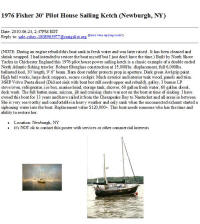 Fate
intervened. During a web search in July I found an
ad on Craig's List for a 1976 Fisher 30 located
relatively close by (New York), and with an attractive
asking price. Fate
intervened. During a web search in July I found an
ad on Craig's List for a 1976 Fisher 30 located
relatively close by (New York), and with an attractive
asking price.
Of course, for the price, there had to be a story, and,
clicking on the ad heading, I learned that indeed there
was: the boat had sunk. Of course, this
didn't deter me in the least, as I have a propensity to
like the challenge represented by ridiculous projects.
The ad was dated a few weeks before, and I was worried
that the boat might be gone. I emailed the seller,
but my email was returned. Undeterred, I emailed
again, with the same result. Oh the frustration!
There was no other means of contact.
|
In desperation, I sent yet another
email--this one from a different, web-based email
account. With bated breath, I waited by the
computer (not really), but this time received no bounced
email error message. Hoping that at least
this email had gotten through to the seller, I patiently
went about my business for several days without a care
in the world. No, that's not quite right:
actually I was beside myself with anticipation and
impatience, but after several days with no response, I
feared the worst.
I was away for a few days, and when I returned I was
thrilled to find an email from the seller: the
boat was still available. Armed now with a phone
number, I immediately called to talk about the boat and
set up an appointment to see her in person. The
on-site visit was important not only to determine the
condition of this boat, but also because I'd never seen
a Fisher 30 (or any Fisher) in person, and we needed to
be sure we liked the feel of the boat and, in
particular, the size and feel of the smallish cockpit.
A week or so later, we made the 14 hour round trip to
see the boat, spending a couple hours on board beneath
blue shrinkwrap in sweltering heat. There are more
details about the first visit in the
Project section of this site. |

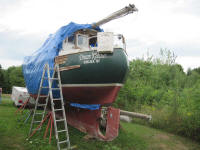
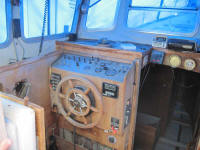

 |
After various discussions, I made an offer on the boat,
which the seller accepted. I made arrangements to
truck her back to Maine, which is where this story
really begins. |
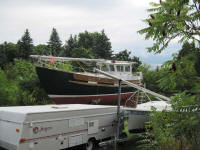
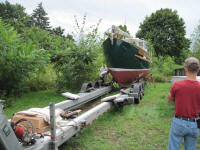
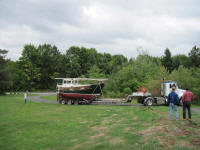

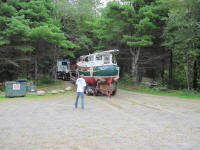
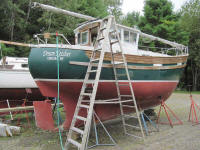
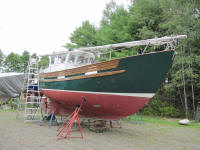 |
Follow along with the project with the daily work logs
in the Project section.
The Project
|
After four and a half years of
mostly steady work--punctuated by a couple longer breaks
during the summers of 2013 and 2014--by March 2015 the
boat was essentially all-new and virtually complete.
However, for a variety of reasons, our plans had
changed: mainly an epiphany on my part that, with
a full-time restoration business, I actually craved--and
needed--leisure time that wasn't related to a boat,
somewhere I could relax and do something entirely
different.
We found this outlet in a small cottage in Prince Edward
Island, Canada, which we bought and refurbished starting
in late 2012. (The lead-in to this is a long story
that I'll not go into here). Finding myself pulled in conflicting
directions by essentially incompatible leisure
activities and limited time off to enjoy them, after
much reflection and internal struggles that took place
over a two-year period I realized that my heart was in
PEI, and that at least for the moment, my love of boats
was being covered by my daily work and that cruising as
we'd planned in this beautiful and comfortable boat
simply wasn't going to be part of the foreseeable
future.
Not wanting to have her languish, or not enjoyed to her
full and excellent potential, we made the tough decision
to put her up for sale. She sold to a local buyer
on April 13, 2015. Read more about this
here.
I agreed to complete various jobs on board for the new
owner, and for continuity's sake I continued to post the
progress logs on this site through the projected launch
date.
|
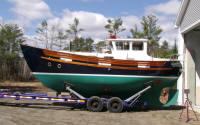
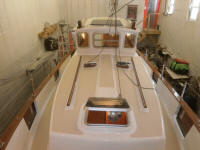

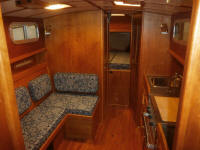 |
|
|























